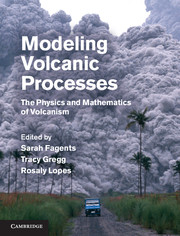Book contents
- Frontmatter
- Contents
- Contributors
- Chapter 1 Introduction
- Chapter 2 Magma chamber dynamics and thermodynamics
- Chapter 3 The dynamics of dike propagation
- Chapter 4 Dynamics of magma ascent in the volcanic conduit
- Chapter 5 Lava flows
- Chapter 6 Unsteady explosive activity
- Chapter 7 Unsteady explosive activity
- Chapter 8 Sustained explosive activity
- Chapter 9 Modeling tephra sedimentation from volcanic plumes
- Chapter 10 Pyroclastic density currents
- Chapter 11 Magma–water interactions
- Chapter 12 Deep-sea eruptions
- Chapter 13 Volcano–ice interactions
- Chapter 14 Modeling lahar behavior and hazards
- Chapter 15 Introduction to quantitative volcano seismology
- Chapter 16 Volcano acoustics
- Chapter 17 Planetary volcanism
- Index
- Plate section
- References
Chapter 14 - Modeling lahar behavior and hazards
Published online by Cambridge University Press: 05 March 2013
- Frontmatter
- Contents
- Contributors
- Chapter 1 Introduction
- Chapter 2 Magma chamber dynamics and thermodynamics
- Chapter 3 The dynamics of dike propagation
- Chapter 4 Dynamics of magma ascent in the volcanic conduit
- Chapter 5 Lava flows
- Chapter 6 Unsteady explosive activity
- Chapter 7 Unsteady explosive activity
- Chapter 8 Sustained explosive activity
- Chapter 9 Modeling tephra sedimentation from volcanic plumes
- Chapter 10 Pyroclastic density currents
- Chapter 11 Magma–water interactions
- Chapter 12 Deep-sea eruptions
- Chapter 13 Volcano–ice interactions
- Chapter 14 Modeling lahar behavior and hazards
- Chapter 15 Introduction to quantitative volcano seismology
- Chapter 16 Volcano acoustics
- Chapter 17 Planetary volcanism
- Index
- Plate section
- References
Summary
Overview
Lahars are highly mobile mixtures of water and sediment of volcanic origin that are capable of traveling tens to > 100 km at speeds exceeding tens of km hr−1. Such flows are among the most serious ground-based hazards at many volcanoes because of their sudden onset, rapid advance rates, long runout distances, high energy, ability to transport large volumes of material, and tendency to flow along existing river channels where populations and infrastructure are commonly concentrated. They can grow in volume and peak discharge through erosion and incorporation of external sediment and/or water, inundate broad areas, and leave deposits many meters thick. Furthermore, lahars can recur for many years to decades after an initial volcanic eruption, as fresh pyroclastic material is eroded and redeposited during rainfall events, resulting in a spatially and temporally evolving hazard. Improving understanding of the behavior of these complex, gravitationally driven, multi-phase flows is key to mitigating the threat to communities at lahar-prone volcanoes. However, their complexity and evolving nature pose significant challenges to developing the models of flow behavior required for delineating their hazards and hazard zones.
Introduction
The Indonesian word “lahar”’ refers to a highly mobile mixture of water and sediment, other than normal stream flow, originating from a volcano (e.g., Fig. 14.1; Smith and Fritz, 1989). The term has genetic connotations rather than implying any particular flow behavior, which can range from dilute hyperconcentrated flows, in which particle concentrations greater than those of normal streamflow conditions are transported chiefly as suspended and bedload sediment, to debris flows in which a high-concentration particulate phase transports sediment en masse with fluid in its interstices (Vallance, 2000). Lahars vary greatly in volume (~102–109 m3), peak discharge (< 10–107 m3 s−1), advance rate (~2–80 m s−1) and runout (a few to > 100 km; Pierson, 1998).
Information
- Type
- Chapter
- Information
- Modeling Volcanic ProcessesThe Physics and Mathematics of Volcanism, pp. 300 - 330Publisher: Cambridge University PressPrint publication year: 2013
References
Accessibility standard: Unknown
Why this information is here
This section outlines the accessibility features of this content - including support for screen readers, full keyboard navigation and high-contrast display options. This may not be relevant for you.Accessibility Information
- 25
- Cited by
